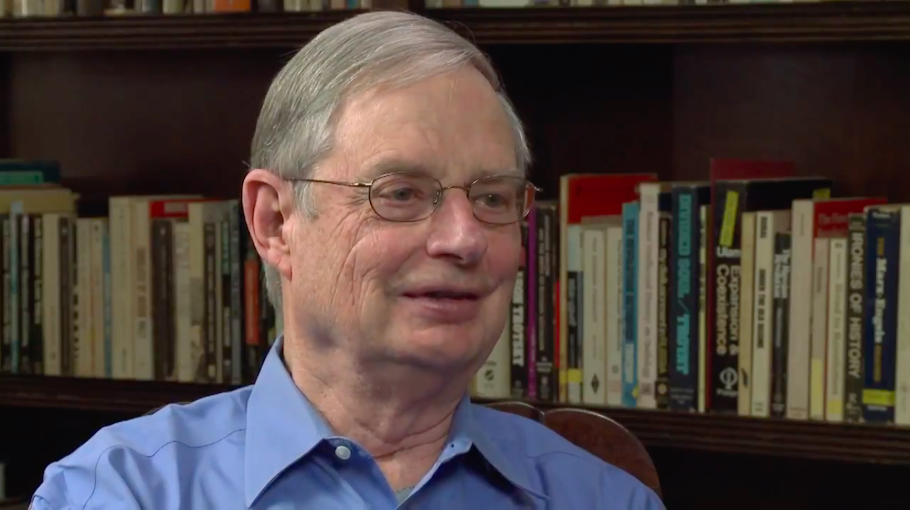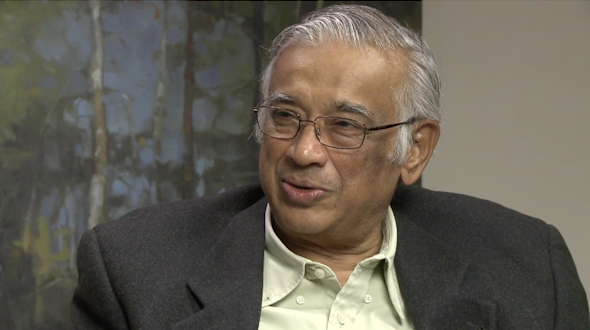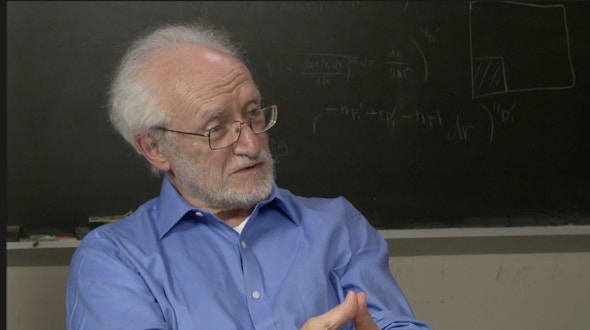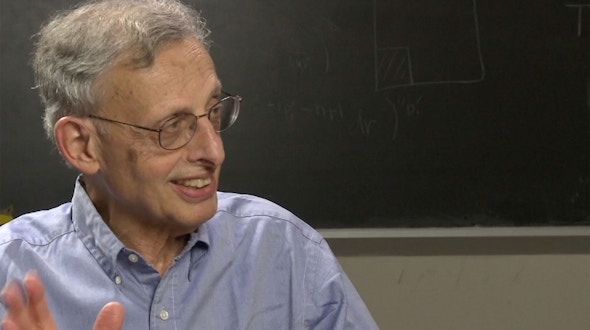Phillip Griffiths
- Highlights (2:32)
- Growing up in Raleigh and Military School (3:01)
- Wake Forest University and Basketball (5:14)
- Getting Started at Princeton (5:10)
- Interest in Geometry (1:58)
- Collaboration Between Kodaira and Spencer (4:36)
- Berkeley and Collaboration With Chern (3:57)
- From Complex Manifold Theory to Algebraic Geometry (4:34)
- Algebraic Cycles (5:54)
- The Confluence of Algebra, Geometry and Analysis (3:37)
- Berkeley (3:33)
- Intermediate Jacobians (2:42)
- Complex Analysis and the Nothing Seminar at Princeton (5:44)
- The Secret to Being an Advisor (1:16)
- Special Graduate Students (1:55)
- Harvard (4:41)
- Working with Students (2:39)
- Eli Cartan and Work With Bryant and Chern (2:16)
- André Weil (5:07)
- The Move to Duke University as Provost (4:28)
- Being Provost at Duke (7:17)
- Director at IAS (9:34)
- Griffiths Collaborations (7:45)
- Current State of Mathematics (2:46)
- Service with Government Bodies (4:48)
- Carnegie Foundation (3:46)
- Millenium Science Initiative (3:12)
- What Makes a Good Martini? (1:25)
- International Mathematical Union IMU (2:17)
Three months into Princeton University’s rigorous mathematics doctoral program, Phillip Griffiths wanted to drop out. A graduate of Wake Forest College in Winston-Salem, N.C., where the math curriculum concentrated on first- and second-year courses, Griffiths felt woefully less prepared than the students who had come from major universities and, as undergraduates, had already taken graduate courses. His peers, he says, “were used to a competitive environment that was new to me.” Over a cup of coffee or tea in the common room, they would probe him about his knowledge of the latest theorems, which he’d never even heard of. So he drove home to North Carolina with the notion of transferring to a school there.
His father, who’d had a hardscrabble early life and ended up working in forestry, would have none of it. He “read me the Riot Act and basically said for me to get my tail back up to Princeton and get to work,” Griffiths recalls. He followed his father’s order, and that fateful decision in 1959 turned out to be a boon not only for mathematics, but also for administration at two of the most prestigious academic institutions in the U.S., as well as for math education worldwide. Griffiths’ decision also set a pattern in his career, whereby he would enter a largely unfamiliar field and eventually assume a commanding position in it. “Usually, when Phillip looks at something intensively enough, progress is made,” says Mark Green, professor emeritus of mathematics at the University of California, Los Angeles, who got his doctorate under Griffiths in 1972.

Griffiths, now 75, attributes his early interest in mathematics to Lottie Wilson, a math teacher at the military academy where he attended high school. Her love of the subject was “infectious,” he recalls. On weekends, he would go over to her house to learn calculus at her kitchen table. “She communicated the beauty of the subject,” he says, rather than presenting math as a field in which one just learns skills and techniques to solve problems. Griffiths’ next stop was Wake Forest (now a university), which permitted him to engage in independent study to learn upper-level math. He then headed for Princeton, which he says had the first top-rate math department as one headed north.
His adviser at Princeton was Don Spencer, whose research was in complex analysis and partial differential equations. Although Griffiths did not end up in Spencer’s field — even his thesis was more geometric than analytic in nature — his adviser taught him something just as valuable as expertise in a particular specialty: how to mentor a graduate student. “He was just a wonderful teacher,” Griffiths remembers. “I’d show up at 9 o’clock in the morning in his office, and he’d give me an hour lecture on some subject. And over the year, it changed from his giving me a lecture to ‘you go read this and come in and give me the lecture, and I’ll critique it.’” Griffiths later applied this strategy to his own 30 or so doctoral students. Some of them recall benefiting also from his uncanny ability to spot the talent hidden in struggling Ph.D. candidates and to harness it productively.
After receiving his doctorate in 1962, Griffiths spent five years at the University of California, Berkeley, as a postdoc and then assistant professor. The experience of living in an urban environment for the first time felt liberating to him — for example, he had never before encountered such exotica as jazz nightclubs. In addition, the city was a hotbed of 1960s agitation. Griffiths taught undergraduate calculus to some of the era’s most politically active students, including Mario Savio, Jerry Rubin and Jack Weinberg of the Free Speech Movement. (He notes, however, that he was, and wishes he could remain, a moderate conservative.) He also taught many graduate courses that he credits with rounding out his math education. “There were things I knew sort of superficially but didn’t really have any sort of deep understanding of,” he recalls. “In mathematics you really understand a subject only if you have to teach it or give talks about it.”
At Berkeley, Griffiths also began to specialize in algebraic geometry, the study of configurations in space defined by algebraic equations. A simple example is the identification of the solution set of the equation x2 + y2 = 1 as a circle of radius 1. Algebraic geometry studies this relationship in far more complex cases, using polynomial equations. Considered pure math, it includes such topics as Hodge theory and Abel-Jacobi maps, both of which involve generalizations of the integrals covered in first-year calculus. Griffiths’ work has had practical implications in cryptography and physics’ string theory, according to Matt Kerr, an associate professor of mathematics at Washington University in St. Louis, Missouri, who studied under Griffiths just over a decade ago. Griffiths and another former student, Joseph Harris, produced one of the standard textbooks in the field. (A curious aside: Harris, a night owl, lived in Griffiths’ house while they wrote the book, and Griffiths, an early bird, would work with him at 5:30 a.m. — perhaps the only time when both authors were simultaneously awake.)
Kerr says that Griffiths’ work follows in the century-old tradition of French mathematician Henri Poincaré, who “favored physical and geometric intuition over pure mathematical rigor.” Griffiths agrees. “Mathematics has in it an inner harmony,” he observes, that even his mother, a pianist and music teacher, could appreciate. “And if you develop a sense of that, then you can, on occasion, get ahead of yourself as to what mathematically would be the harmonious way that a problem could be solved.” But he stresses that, although one can make intuitive leaps, rigorous proof is still the standard of mathematics.
After leaving Berkeley in 1967, Griffiths held faculty appointments at Princeton and then Harvard that lasted until 1983. The move to Harvard was particularly auspicious for his wife, Taffy, whom he had met at Berkeley when the university’s employment office assigned her to type one of his papers. A comparative religion major at Berkeley, she had decided to go to medical school, and she chose Tufts University, close to Harvard. She had begun her neurology residency in the Boston area when another major turning point in Griffiths’ career occurred.
At the time, Griffiths was regularly traveling down to North Carolina to care for his ailing father, and nearby Duke University was looking for a new provost. Its president, Terry Sanford, cajoled him into considering the job, calling him “son,” in Southern fashion, during their chat and telling him that the provost essentially “takes care” of the faculty (while the president looks after the students, alumni and trustees). Sanford, who had long known Griffiths’ father — and had been North Carolina’s governor, to boot — then told the skeptical search committee that Griffiths had the requisite human qualities for the job, even though he had no experience in administration. For his part, Griffiths missed living down south and hankered for something a bit different from being a faculty member in mathematics. Duke offered him the position, and he accepted.
Duke eased Griffiths into the job, and in Cambridge, legendary Harvard dean Henry Rosovsky informally tutored him every few weeks about university administration, as Griffiths commuted between Duke and Harvard. According to his former graduate student, Mark Green, Griffiths started by wandering from department to department at Duke, meeting with faculty members for an hour or so, and asking them to tell him about their field as it was represented at Duke and about its challenges and advances, in general. “He learned a lot about what was important in different fields,” particularly the humanities, Green says. Meanwhile, Griffiths also taught undergraduate math and did research.
Since the late ’60s, Griffiths had maintained sporadic contact with the Institute for Advanced Study (IAS), a small but immensely prestigious academic center in Princeton. So when the institute was seeking a new director in 1991, he was a natural choice, as an administrator with eight years’ experience. With the help of assistants, Griffiths met the challenges of the job, but he initially had trouble with one aspect: fundraising. “Part of the tradition of the South is self-sufficiency,” he notes. “So it’s hard for me to ask people for money.”

Arlen Hastings, his executive assistant for 11 years at IAS, recalls Griffiths as “an interesting, quirky guy” who could be reserved when meeting someone for the first time but sociable and outgoing with people he knew well. “A lot of fun” to work for, Griffiths “was the opposite of a micromanager,” she remembers. “He would find people who knew how to do things and put them on those tasks,” then be very grateful for the work they did. During his 12-year directorship, he spearheaded many academic changes at IAS, such as adding a theoretical biology program and bringing the Park City Mathematics Institute in Utah under the IAS umbrella. He addressed quality-of-life issues as well, developing a day care center and a new fitness center, and he initiated Wednesday-night buffets to encourage interaction between members of different departments.
Griffiths left the IAS directorship in 2003 to focus more on research, and he formally retired in 2008. But he hasn’t rested on his laurels. He spends a couple of days a week at IAS, where he and Green are now finishing a monograph on algebraic geometry, and where he hopes to mentor more graduate students. He collaborates on research with several former students, making copious use of the fax machine to transmit reams of notes. And after three decades of working with various national groups to address policy issues in science and math, he’s still in the public arena. He and Green, together with a small group of colleagues, are working on a project to transform post-secondary math education. Another project, with Hastings, is aimed at supporting graduate students in sub-Saharan Africa. “He is the face of [the project] when we need a high-level person, and he’s also a very good strategizer,” Hastings says. Griffiths insists that he accomplishes all this work while getting a good seven to eight hours of sleep every night.
Griffiths can point to many accomplishments in academia, but he is also proud of another of his passions, sailing. As a child living on the North Carolina coast, he began plying small boats on lakes. Then, in the 1980s, he and his wife bought a 35-foot boat, later graduating to a 43-foot ketch, a sea boat. Their maritime exploits culminated in a trans-Atlantic trip during the summer of 1997. They and four friends spent six weeks sailing from a marina near the Statue of Liberty to Turkey, and most of the way back. (To avoid hurricane season, they switched to commercial aviation for the last leg of the return trip.) “I just love the open ocean,” Griffiths says. “There’s an old saying that a bad day on the water is better than a good day on land.” He and Taffy still paddle kayaks in the Chesapeake Bay near their second home.
Griffiths attributes much of his success to his early experience at a military academy. In the cadet corps, whether as a sergeant, lieutenant, major or colonel, “you see what needs to be done and what the issues are,” he says. “But above all you just keep things moving along.” Another key to his accomplishments is collaboration. “When I look around at the various things I’m involved with, they’re always done with other people,” he observes. “It makes it seem like you’re doing much more than you are actually doing when you have such good people that you’re working with.”




